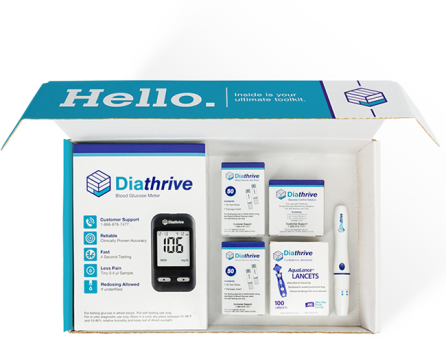
Following your diabetes care plan is first in bringing down your blood sugar, but what you eat, your lifestyle, stress, sleep and other things also influence your average blood glucose.
If you are newly diagnosed with diabetes, you are learning that there are lots of things that can affect your blood sugar levels.
You have learned how to monitor your blood sugar and have acquired all the diabetes equipment and supplies needed to manage your condition.
You also discovered that there are many resources available to help you learn about diabetes, including articles like this one and the rest of the diabetes resources on the Diathrive blog.
You are doing fine, but have some questions like: What can I do to help keep my blood sugar at normal levels? How can I bring blood sugar down at home? Here’s a few tips to keep in mind.
What is normal blood sugar?
One of the most important things to know if you have to manage blood sugar is that "normal blood sugar" isn't a number. It is a range.
For people who do not have diabetes, normal blood sugar is generally a range from as low as 70 milligrams per deciliter (mg/dL) up to around 130 mg/dL depending on time of day, when they last ate, and what they ate. That is because for people who have a fully-working pancreas, the body is able to handle rises and drops in blood glucose levels naturally. But when it comes to people living with diabetes, normal isn't always the same. And to maintain a healthy range there is much more manual work involved.
Because everyone is different, your health care provider will help you establish your target blood sugar range considering how your body metabolizes and uses nutrients — though, it’s worth noting that the average ranges established by the American Diabetes Association are fairly accurate for a majority of people.
When you know your target range, you can modify your medication and lifestyle to help manage your diabetes and avoid complications. Let’s review some blood sugar guidelines.
Milligrams (mg) per deciliter (dL) is how your blood glucose meter reports your blood glucose level, so you don’t have to do any fancy calculations – just check your blood sugar level using your blood glucose meter.
If you are diagnosed with diabetes, your blood sugar level two hours after a meal should generally be less than 180 mg/dL. If your blood sugar is above 180 mg/dL two hours after a meal and you have not made recent changes to or missed medications, consider talking with your health care provider about possible reasons why, because you might need to adjust your diabetes management plan. Blood sugar levels in the morning (fasting blood sugar) or before a meal should be between 80 and 130 mg/dL.
Two of the terms you should know related to blood sugar levels are:
-
Hyperglycemia, which means you have high blood sugar. When you live with type 1 diabetes, it means there is not enough insulin to process the sugar in your blood. For people living with type 2 diabetes or prediabetes, your body is not making enough insulin or not using the insulin you have efficiently. Symptoms of hyperglycemia include excessive thirst and increased urination, increased thirst, excessive hunger or fatigue, high heart rate, difficulty breathing, and stomach pain.
-
Hypoglycemia means you have low blood sugar. Symptoms you might feel with hypoglycemia are feeling hungry, tired, or disoriented. You might look pale and have an abnormal heartbeat. Taking glucose tablets or eating specific foods can help bring your blood sugar back up to normal.
The focus of this article is how to bring your blood sugar down when you have or are approaching high blood glucose levels (hyperglycemia).
How can I reduce blood sugar levels?
There are many things that can cause blood sugar to rise, and many things you can do to help control your blood sugar levels.
If your diabetes management plan includes insulin, taking a dose of insulin is the best way to lower blood sugar. Be sure to administer insulin based on your doctor's recommendations.
There also are lifestyle strategies that can help you manage your blood sugar. These do not replace insulin or other diabetic drugs your health care provider has prescribed but are part of your overall diabetes management plan.
So, what can you do at home to reduce your blood sugar?
It’s worth repeating that the first and most important way you manage your blood sugar level is by following your diabetes management plan. The best way to know whether or not your blood sugar stays in your target range is to understand how your blood sugar fluctuates throughout the day. This can also help you identify foods and other factors (like the ones discussed below) that affect your blood glucose level.
Measure your blood glucose level as directed by your healthcare provider, and follow your diabetes management plan. This includes insulin if you are living with type 1 diabetes, and medications (sometimes including insulin) if you are living with type 2 diabetes.
Certain lifestyle strategies help reduce your blood sugar levels. Some strategies like getting good quality sleep might be surprising, and others like exercise are not surprising at all.
Let’s review lifestyle strategies that help lower your blood sugar:
-
Drink water. Dehydration means you have less water in your body, which increases the concentration of sugar in your blood. Water helps rehydrate your body and helps keep your blood sugar within healthy limits. Additionally, drinking more water can help your body flush out excess glucose through urine.
-
Exercise. Exercise tells your body that it is time to turn sugar into fuel for your muscles. Exercise works well for people living with type 2 diabetes because it can help increase insulin sensitivity, which means your cells are better at using the available glucose in your bloodstream. Don’t like to exercise? Increase activity in your life by doing things like walking the dog, working in the yard or house, and parking your car farther away from stores.
-
Manage Stress. Did you know that when you are stressed, your body releases hormones like cortisol and glucagon that cause your blood glucose levels to rise? This is a natural reaction that gives you a burst of energy to deal with whatever is causing the stress. Without enough insulin on board to convert the sugar to energy, people with diabetes see a rise in blood sugar instead. Sometimes, it’s not easy to reduce stress in your life, but stress-reducing strategies include doing things that ease your mind. This could mean taking a walk, doing yoga, meditating, or just taking a break and relaxing. Therapy also is an option – having someone to talk to can help ease stress in your life.
-
Sleep. Like stress, sleep deprivation increases cortisol levels, which affects blood sugar management. Lack of sleep can also increase your appetite, leading to weight gain. Maintaining a healthy weight promotes healthy blood sugar levels. Do you have trouble sleeping? Sometimes, diabetes can contribute to that.
Being mindful of food
Of course, the list of ways to manage blood sugar at home must include a discussion of the amount and quantity of food you eat.
This not only includes reducing the amount of sugar in your diet, but other less-obvious food choices that can help manage your blood sugar. These include:
-
Watching your sugar intake. Try cutting the usual amount of sugar you use in half and then go down from there. Reduce the table sugar, syrup, and honey. Add fruit to cereal instead of sugar. Swap water for soda. Check food labels and avoid added sugars. Use extracts (almond, orange, vanilla) without sugar for added flavor. Spices like ginger, cinnamon, nutmeg and allspice provide great flavor without added sugar.
-
Monitoring carbohydrates. Your body breaks down carbohydrates into glucose. If you eat too many carbohydrates, your blood glucose levels rise. A diet low in carbohydrates will naturally help reduce blood sugar levels. Try a low- to moderate-carb approach and see the difference.
-
Being mindful of when and how much you eat. Portion control helps maintain healthy weight which promotes healthy blood sugar levels. Portion control helps you regulate how many calories you eat and maintain a healthy weight. Because portion sizes have increased over the years, it’s easy to understand how we eat more than we should. Use smaller plates, avoid buffet restaurants, read labels and check serving sizes.
How much you eat is important, but the frequency at which you eat also influences blood sugar levels. Your healthcare provider or a dietician can help you establish good eating habits. -
Eating more fiber. Fiber helps manage blood sugar by slowing digestion of carbohydrates and sugar absorption into your blood, which helps promote a more gradual rise in blood sugar. High fiber food includes whole grains, fruit, vegetables, and legumes.
-
Eating more vegetables. All vegetables? Well, not exactly. While there is room for all the vegetables in healthy eating habits, some vegetables are higher in carbohydrates than others. Vegetables like lettuce, cauliflower, spinach, kale, Brussel sprouts, and broccoli have about half the carbohydrates as starchy vegetables like peas, corn, and squash.
Summary
You are learning more and more every day about how to live a healthy life with diabetes. You have worked with your healthcare provider to establish a diabetes management plan, and are learning how your lifestyle can affect blood sugar levels.
There are many things you can do to bring your blood sugar down at home -- many of them, like watching what you eat, getting adequate rest, and managing stress are good for everyone.
Sources:
Tips for Cutting Down on Sugar | American Heart Association
Type 1 & 2 Diabetes: Five Simple Ways to Lower Your Blood Sugar | Diabetes Health
Diabetes prevention: 5 tips for taking control | Mayo Clinic
10 Surprising Things That Can Spike Your Blood Sugar | Centers for Disease Control and Prevention




